.22 Creedmoor Exclusive
The Ultimate Varmint Cartridge?
feature By: Patrick Meitin | February, 21
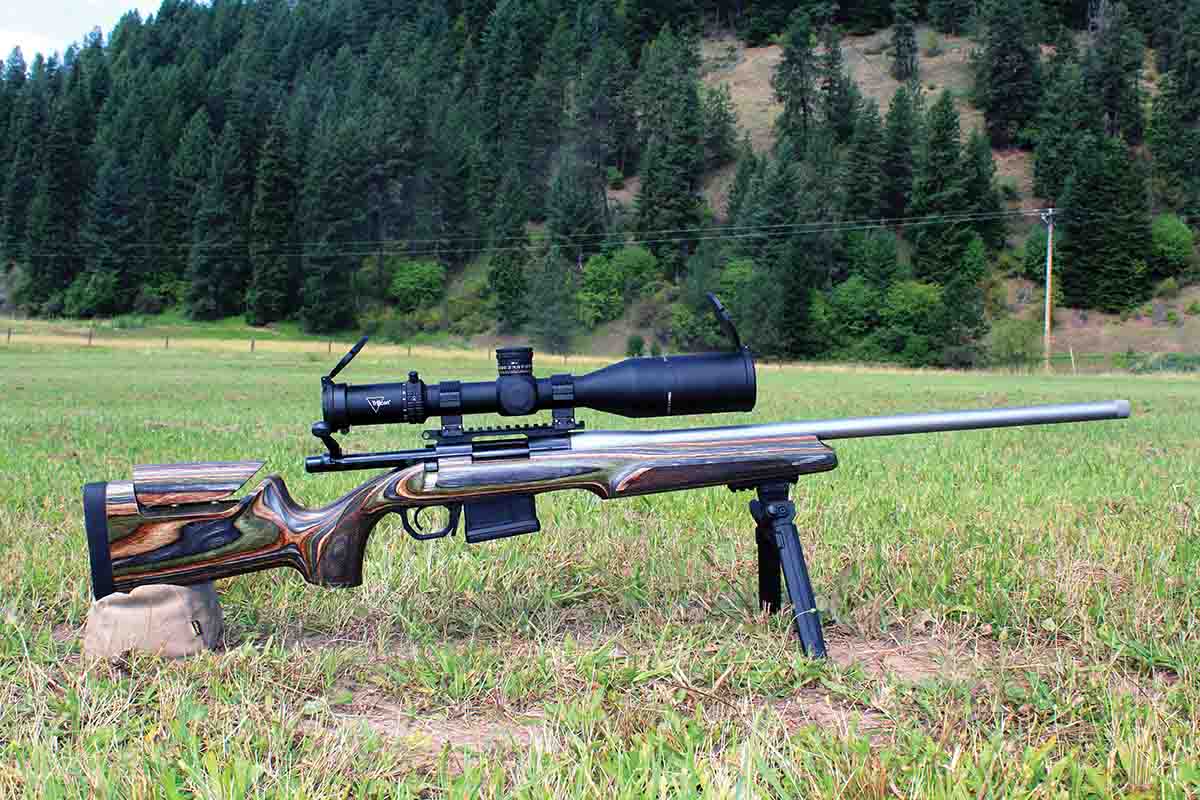
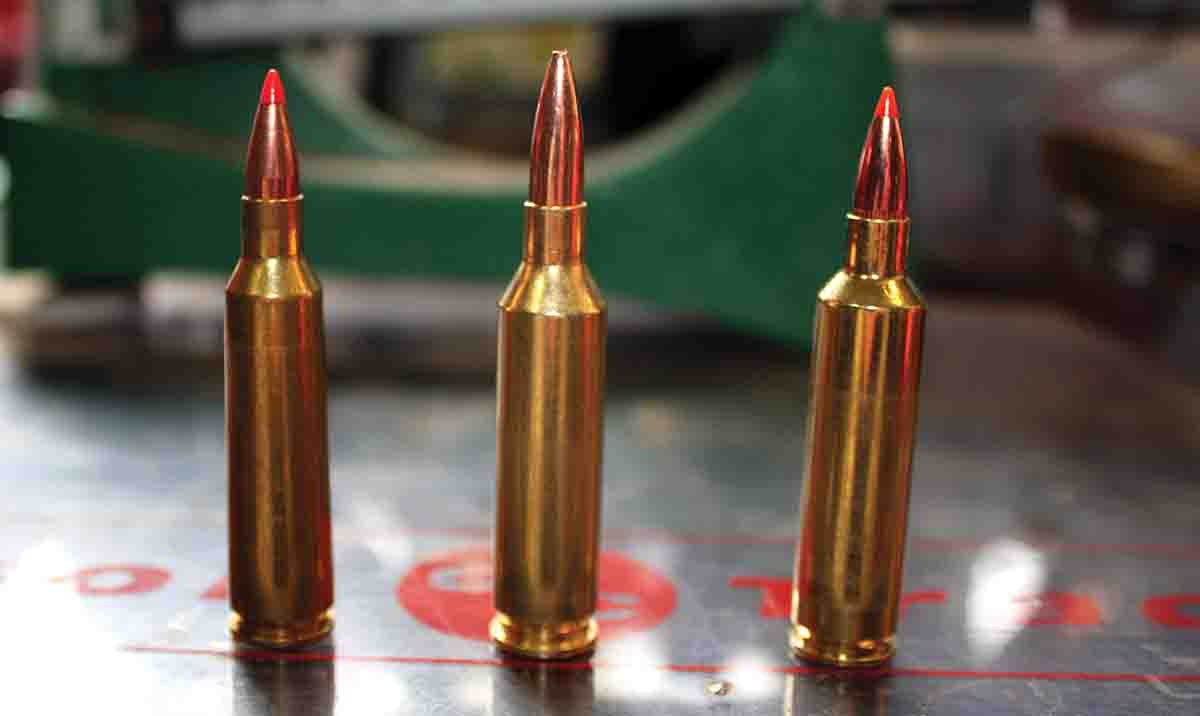
If you make a habit of perusing gun magazines, for the past several years you could be excused for believing the 6.5 Creedmoor was the only centerfire cartridge of significance. Though gun writers can’t seem to discuss anything else today, the round never really grabbed me. My obsessions lean heavily to burrowing rodents or predators willing to investigate the morbid cries of dying bunnies. So, it wasn’t until the 6mm incarnation appeared that the Creedmoor name entered my orbit.
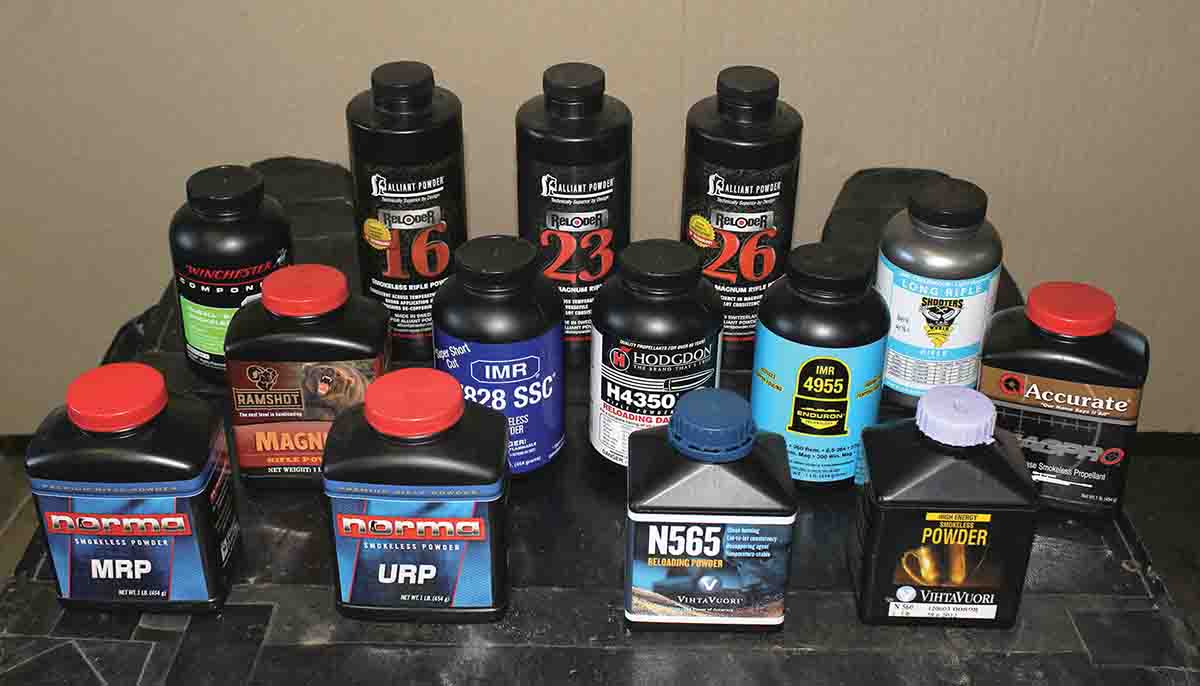
My first was chambered in Ruger’s Precision Rifle topped with a Vortex Optics Viper PST 6-24x 50mm scope. That combination worked well when distances exceeded 400 yards, especially when prairie winds stir. The thing that makes that rifle sing, besides the chassis design and precision turret system, is its 1:7.7 rifling that stabilizes long-for-caliber 6mm bullets with exceptional ballistic coefficients (BC).
When I heard the first rumblings of a .22 Creedmoor, my first thoughts were of gross overbore and short barrel life, but I was also envisioning 55-grain bullets pushed to 4,000-plus fps. When I had the opportunity to hold a 6mm Creedmoor next to a .22-250 Remington, my assumptions proved somewhat overblown.
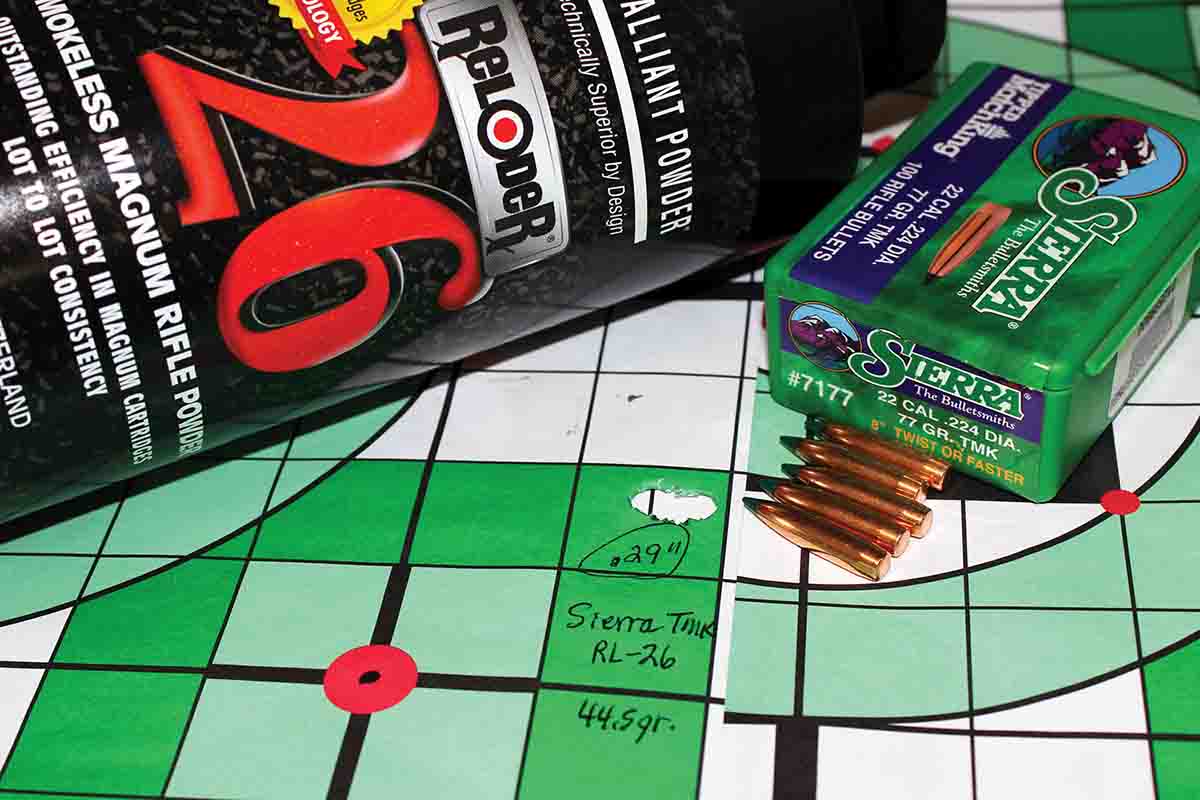
I had also discovered the .22-250 Ackley Improved closely mirrors the .22 Creedmoor (CM) dimensionally. The notable difference is .22 CM rifles are normally equipped with faster rifling twists to stabilize heavier, higher BC bullets. Shooting heavier bullets at more reasonable velocities also calms some barrel-burning qualms. This also creates a different beast altogether, including higher maximum pressures (based on SAMMI 6mm CM numbers). The .22-250 AI and .220 Swift, with their traditional 1:14 to 1:12 rifling, will always be limited to lighter, low BC bullets and all that entails.
Building a fast-twist Swift (Rifle’s Varmint Rifles & Cartridges, Fall 2019) included a long action and gunsmith involvement, and the .22-250 AI isn’t exactly mainstream. Alpha Munitions, Petersen Cartridge, Quality Cartridge and Hornady offer properly-headstamped brass, though creating .22 CM brass is no more difficult than running factory 6mm CM cases through a full-sizing die, with no trimming required, though some neck turning may be required.
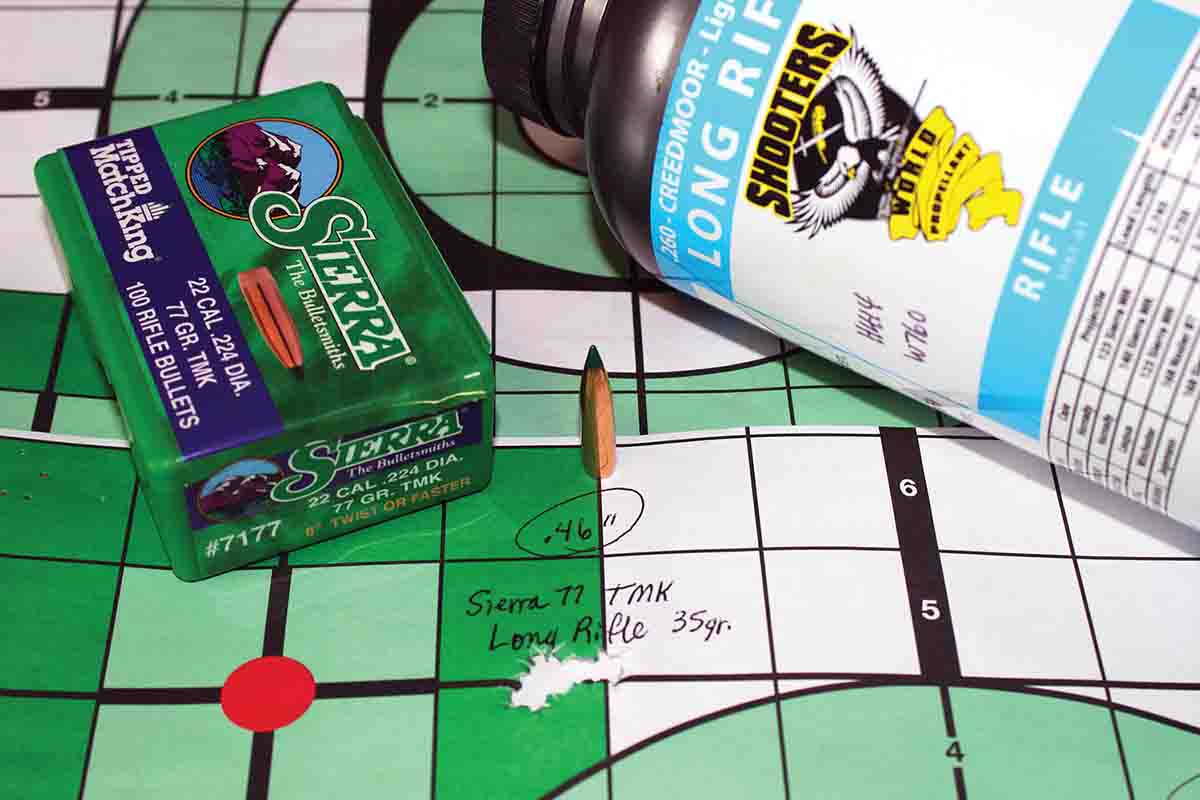
Still, finding .22 Creedmoor load data proved hit and miss – with plenty of spooky loads floating around internet chatrooms. This leaves .22-250 Ackley Improved data as a viable starting point. Fireformed Remington .22-250 AI brass holds 50.5 grains of water and a new Hornady .22 CM case 51.0 grains. Though .250 AI recipes rarely include bullet weights exceeding 60 grains. With a rifling twist rate of 1:7, bullets up to 85/90 grains become viable in my .22 CM. Many of the loads listed here were established by extrapolating .250 AI loads, with Rob Behr (formally of Western Powders) and the guys at Capstone Precision (Lapua/Berger/Vihtavuori) also running some QuickLoad software for me.
None of the “Big-Five” rifle makers have expressed interest in the .22 Creedmoor at this time. This leaves custom rifles, and for that I turned to Dale Hegstrom, owner of Little Crow Gunworks. I started by gathering required parts: a new Remington 700 .308 action, Timney Trigger, PROOF Research barrel blank with a 1:7 twist (ordered through stockysstocks.com), a Stocky’s AccuBlock EuroMatch adjustable cheekpiece laminated stock and a MAGPUL magazine well kit with a PMag 10-round box magazine.
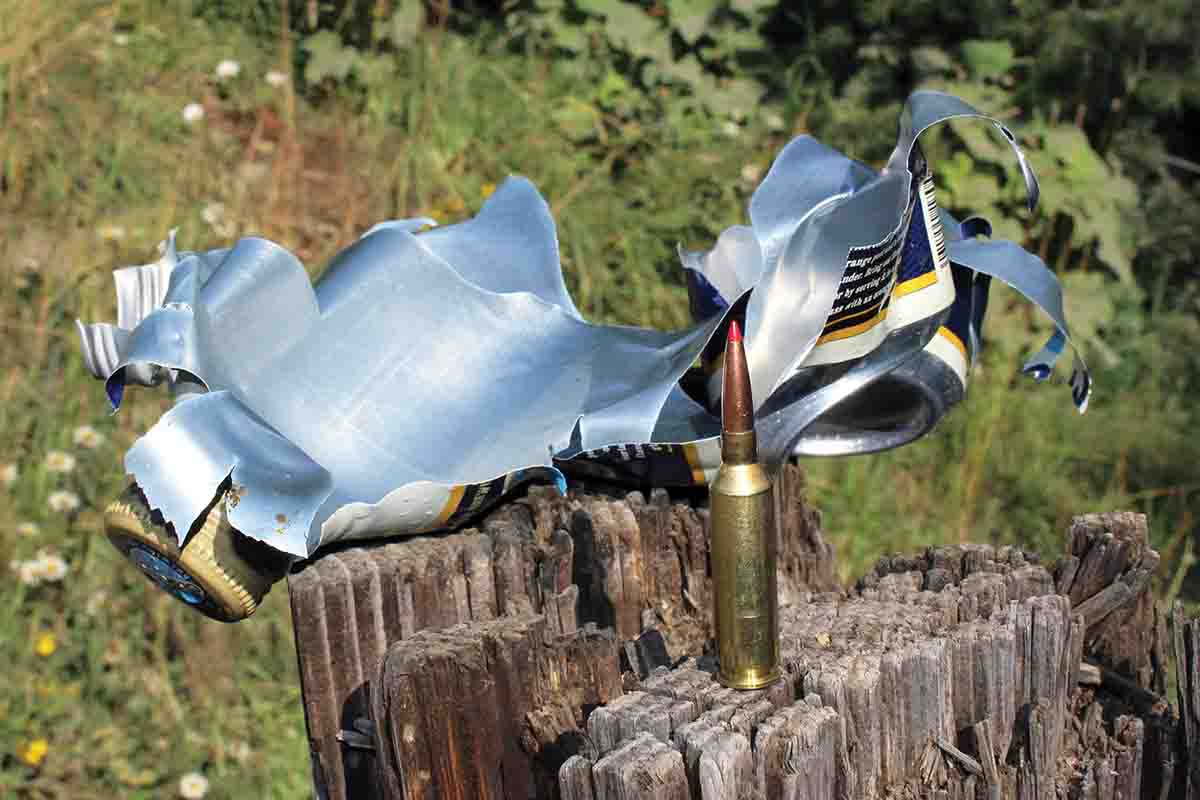
Hegstrom prepared the blank, producing a 26-inch finished length with muzzle threads to accept a suppressor, included a recoil lug and trued the action and bolt head. A short piece of Picatinny rail was installed on the forearm to accept a MAGPUL bipod. Hegstrom skim bedded the recoil-lug area (The stock included a precise aluminum bedding block and didn’t require full-blown glass bedding.), assuring this outfit would shoot its very best. This is the first time I’ve enjoyed the luxury of handpicking every component during a custom-rifle build, and Hegstrom is a true master.
From the perspective of an obsessive varmint shooter, the resulting rifle is a thing of beauty. It weighs 13.36 pounds with a Trijicon 4.5-30x 56mm AccuPower scope installed in 34mm Precision Hardcore Ranger Rings on a 20 MOA Tru Level Picatinny rail by the same maker. I consider this Trijicon and its exposed-turret system an ideal fit. The Timney Trigger was adjusted to break at a crisp 1.53 pounds.
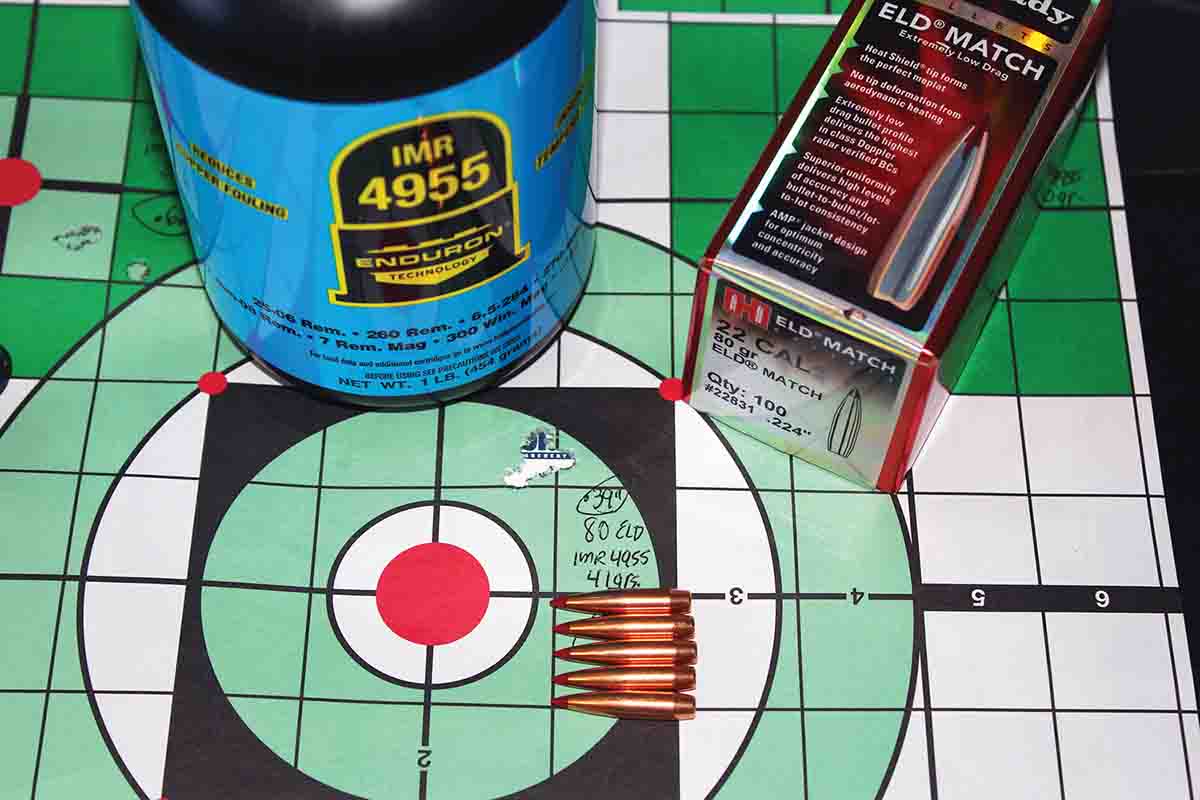
New, properly-headstamped brass was ordered from Hornady and was used in all loads. I ran this brass through Hornady’s Custom Grade full-length dies, uniformed necks on my old Lyman Universal trimmer and chamfered each mouth on Hornady’s Lock-N-Load Case-Prep Trio. Federal Premium Gold Medal 201 Match primers were seated.
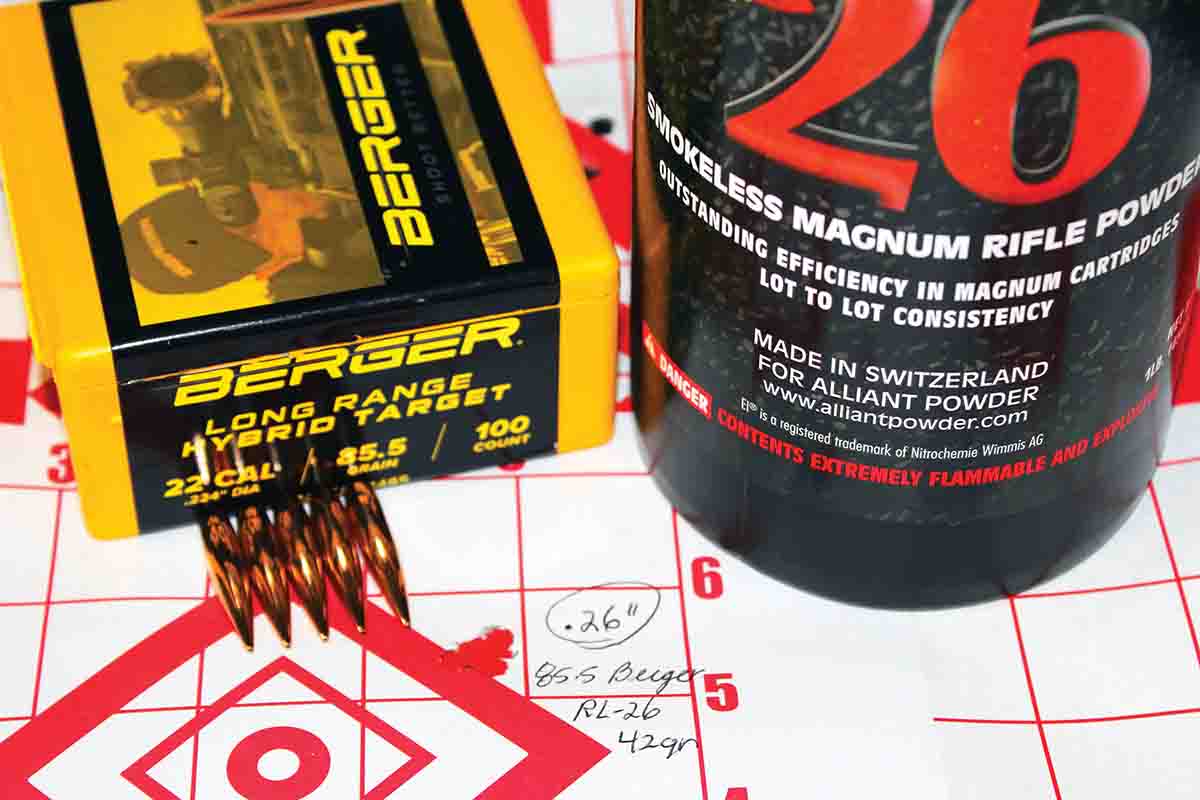
Relatively slow-burning powders were chosen to accommodate the .22 Creedmoor’s overbore dynamics, leaning heavily on temperature stable formulas and/or those with de-coppering agents when possible. Bullet choice became more excruciating. There was the obvious temptation to add some 55- to 69-grain bullets, just to see what kind of velocity would be generated, but I have access to the 1:9 twist .220 Swift mentioned earlier to handle such duties at similar speeds so resisted. I started with 77-grain bullets and went to 90, where I entered ballistic-coefficients normally found in heavier 6mm bullets.
Sierra’s 77-grain Tipped MatchKing (.420 BC) is a design I’ve come to depend on for long-range varmint shooting. They’re predictably accurate and the polymer tip initiates ample expansion on prairie dog to rockchuck-sized critters. Shooters World Long Rifle, using loads developed on QuickLoad by Rob Behr, proved pretty consistent, the best group resulting from 35 grains at 2,960 fps (.46-inch); 37 grains at 3,132 fps produced a .50-inch group with a 12-fps extreme velocity spread. The first near .25-inch group resulted from 44.5 grains of Alliant Reloder 26 at 3,388 fps, which also included a single-digit extreme velocity spread. Winchester StaBALL 6.5 didn’t shine until reaching a 40-grain “maximum” load, printing .36 inch at 3,244 fps. Reloder 26 is the clear winner here, providing both consistent accuracy, low extreme velocity spreads and top velocities.
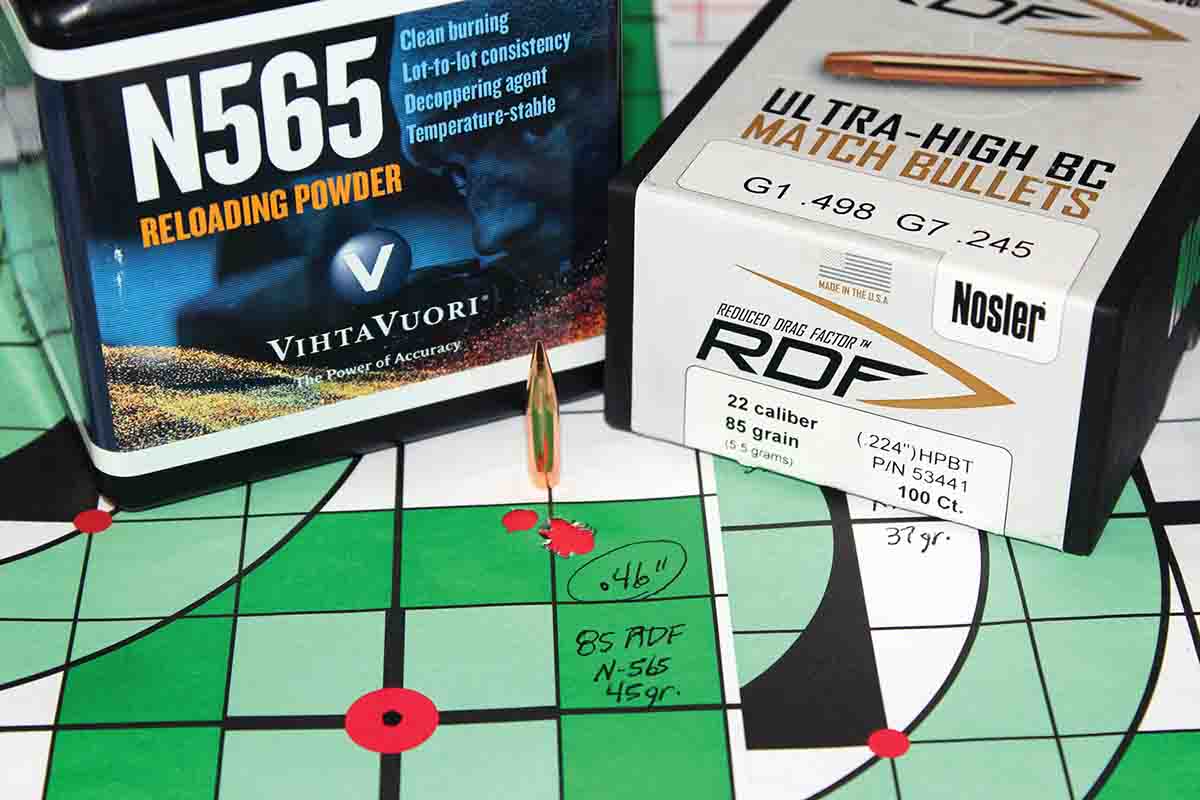
The Hornady 80-grain ELD Match enters the realm of true long-range territory, owing a .485 BC, and handily exceeding the .450 threshold I consider a touchstone for varmint shooting beyond 400 yards, especially when wind stirs. I doubted these bullets would expand on smaller burrowing rodents, but after shooting water-filled aluminum cans at 200 yards, that notion was erased. These bullets turned those cans inside out. After the rifle was completed, Hegstrom requested ammunition to verify feeding and overall function. I chose a completely random load of 41 grains of Vihtavuori N560 beneath this bullet. The very first group from this rifle with this random load produced a .50-inch, five-shot, 100-yard group.
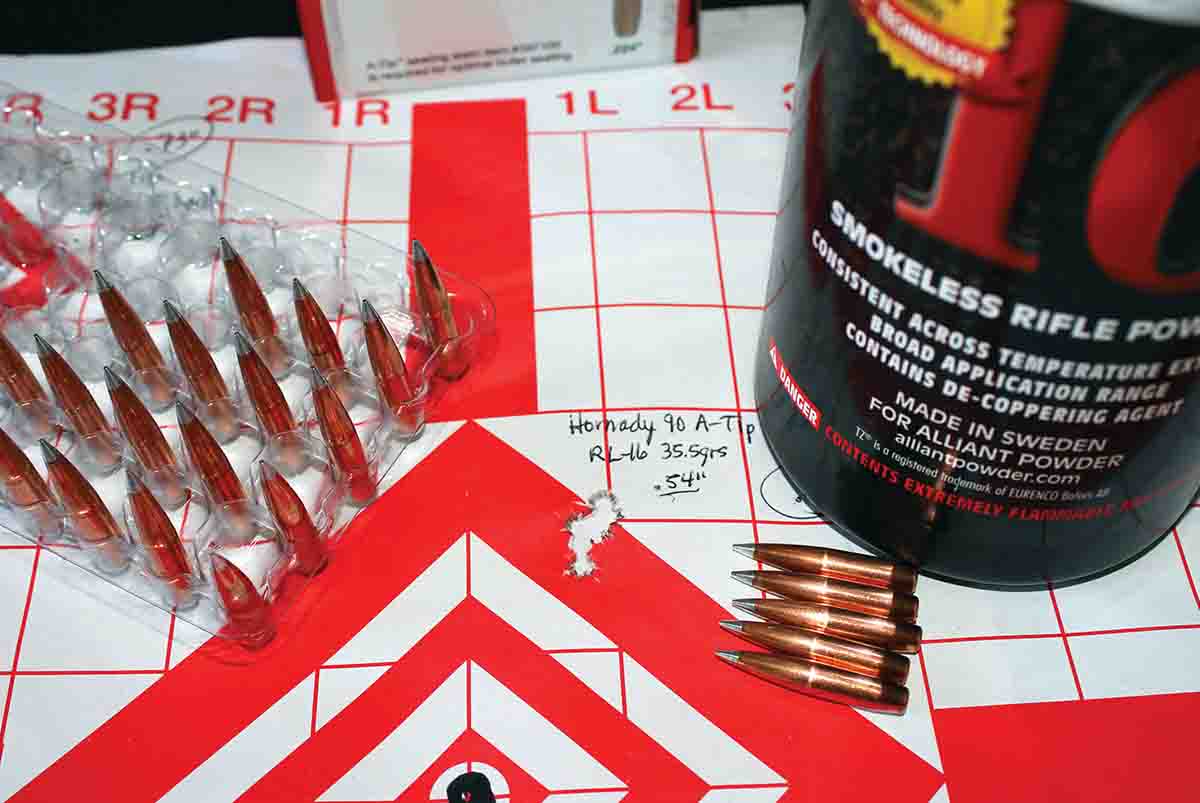
After the barrel was broken in a bit (following PROOF Research’s recommended procedure), that very load produced a .28-inch, 5-shot 100-yard group at 3,139 fps. In fact, all 80-grain ELD Match loads printed less than an inch, only one breaking .75 inch. Using 43 grains of VV-N560 produced a .58-inch group at 3,295 fps. IMR-4955 Enduron did its best work as loads approached maximum (an arbitrary term with this new cartridge), assembling a .39-inch group at 3,272 fps. Past experiences with Enduron powders mirror this experience, with groups often tightening as loads approach maximum. Norma’s time-tested MRP proved remarkably consistent with 41.5-, 42.5- and 43.5-grain charges producing nearly identical groups of .45, .46 and .47 inch, respectively, at velocities from 3,198 to 3,371 fps.
Nosler’s 85-grain RDF, with a .498 BC, is not a bullet likely to expand properly on small varmints, though it would make an ideal choice for shooting predators destined for the raw-fur market. Accurate MAGPRO turned in lackluster results, with most groups breaking an inch, though not by much. Alliant Reloder 23 improved things substantially, with 40 grains resulting in a .28-inch group at a zippy 3,334 fps and with an extreme velocity spread of 37 fps. Increasing that charge to 42 grains resulted in 3,443 fps, but a larger .66-inch group with a slightly lower extreme velocity spread. Vihtavuori’s N565 didn’t produce a noteworthy group until it hit “maximum,” with 45 grains printing .46 inch at 3,257 with a 38-fps extreme velocity spread.
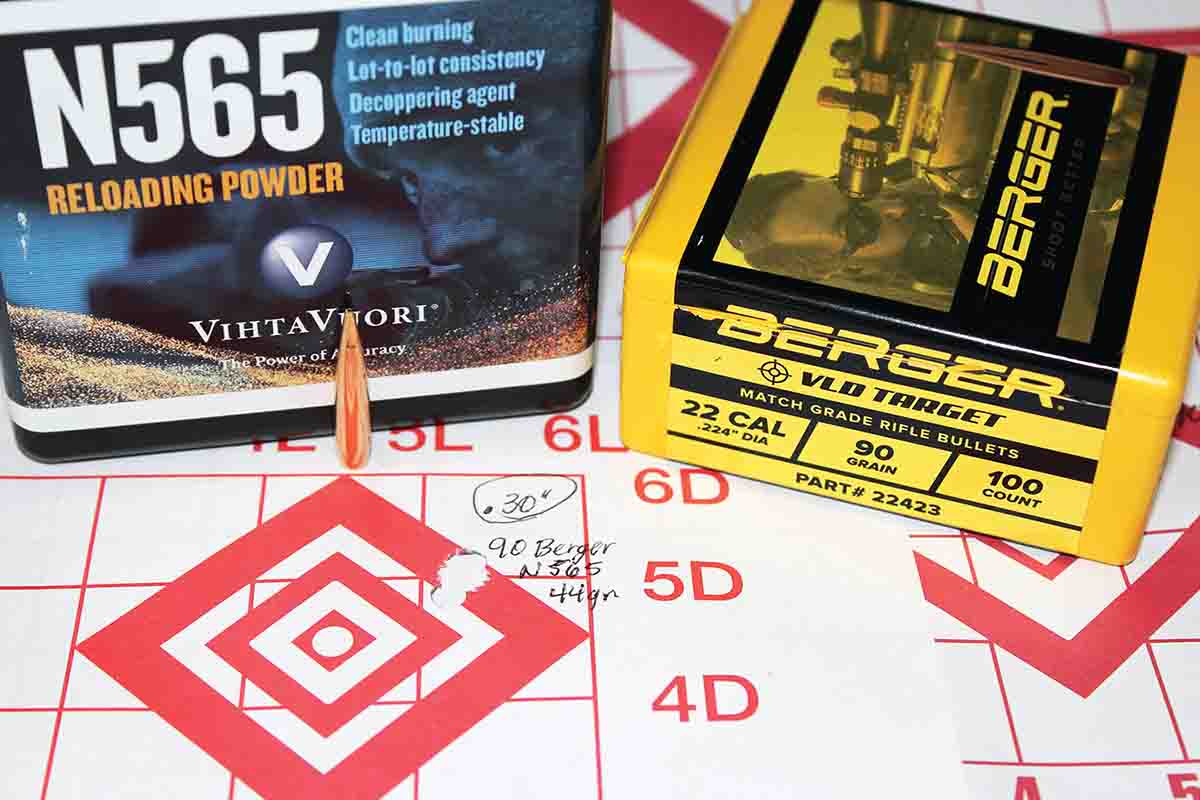
I’ve experienced fairly reliable terminal performance on small varmints with Berger 6mm bullets, and the company’s .224-caliber, 85.5-grain Long Range Hybrid Target is one of its newest offerings. It includes a .524 BC and accuracy-enhancing construction. Hodgdon H-4350 was touted as an early .22 CM favorite, but it managed only .52 inch with its best load; 37.5 grains at 3,087 fps. Ramshot Magnum, relative to other options from this rifle/cartridge, provided groups from .60 to .92 inch at 3,136 to 3,336 fps despite very low extreme velocity spreads. Reloder 26 proved worthwhile yet again, printing .26 inch at a respectable 3,202 fps. Increasing charge weight and velocity doubled that group size.
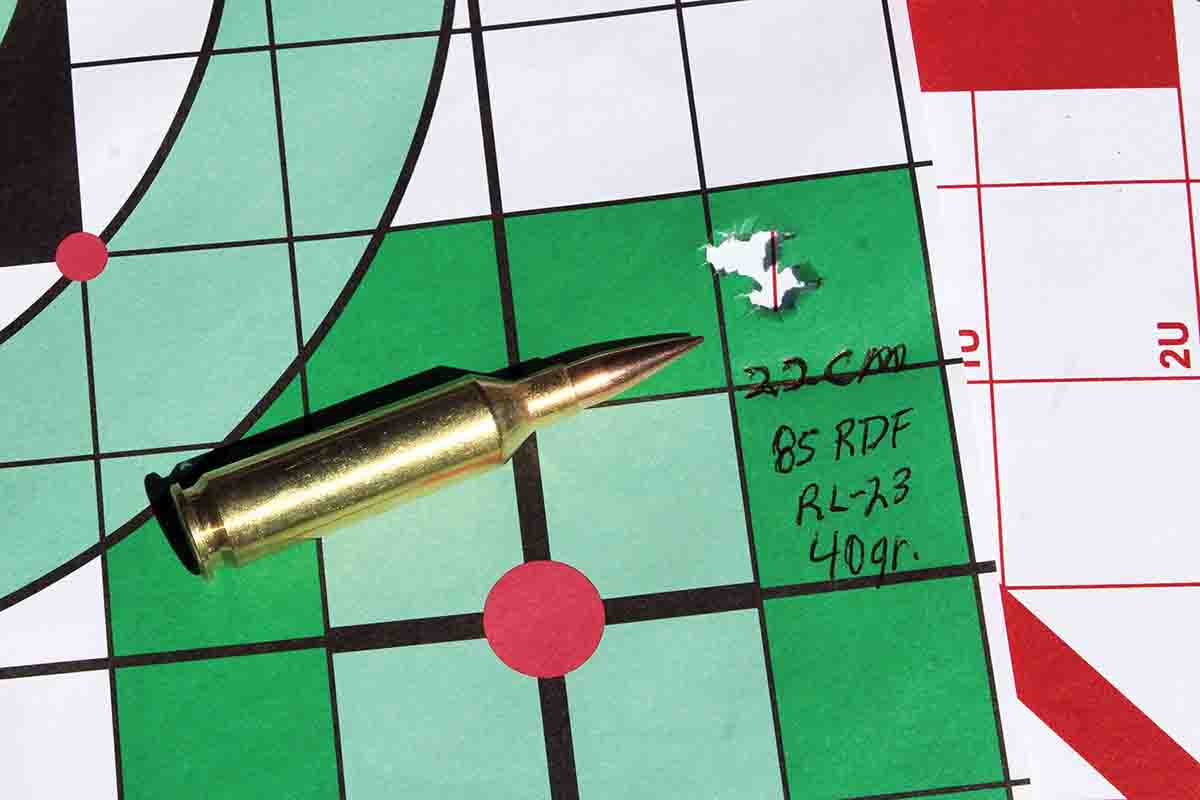
Berger’s 90-grain VLD Target bullet shot from my .223 Remington AR-15 with a 1:7 twist has successfully killed everything from Wyoming long-range, windy-day prairie dogs to brush-country Texas hogs. I expect terminal performance can only improve after boosting velocity 500 fps via the .22 Creedmoor. With a ballistic coefficient of .527, this bullet is long-range ready. It is also remarkably accurate. Vihtavuori’s N565 did best as velocity increased, with 43 grains at 3,100 fps printing .55 inch and 44 grains at 3,169 fps grouping into .30 inch. Alliant Reloder 23 proved quite compatible with the .22 CM, with 39.5 grains at 3,076 fps producing a .45-inch group, and 40.5 grains at 3,114 fps the smallest group of the entire test, .25 inch with only a 22-fps extreme velocity spread. Norma URP deserves more exploration because all loads grouped into less than an inch.
Hornady’s A-Tip Match is a long-range optimized design with a milled aluminum tip sharper than polymer designs. The newest introduction to the lineup is a 90-grain, .22-caliber bullet with an astounding .585 BC – and the highest that will reliably stabilize in a 1:7 twist. The only .224-inch bullet with a higher BC is Sierra’s 95-grain MatchKing with a .600 BC. This was the first bullet I shot through this fresh barrel. Only one of nine A-Tip loads printed groups larger than an inch, with one right at an inch. All powders tested shot close to or less than .5 MOA with at least one combination. MAGPRO produced a .59-inch group at 2,979 fps with 43.5 grains of powder. An extra grain of powder broke 3,000 fps but opening that group to an even inch. Reloder 16 printed a .54-inch group at only 2,821 fps with 35.5 grains of powder and .64 inch with an added grain of powder at 2,910 fps (12-fps extreme velocity spread). The best A-Tip group, a .38-inch one-holer, resulted from 40.5 grains of IMR-4828ssc at 2,926 fps (23-fps extreme velocity spread). I’m hopeful A-Tip groups will tighten as the barrel breaks in. I’m also eager to test powders that excelled with the 90-grain Berger.
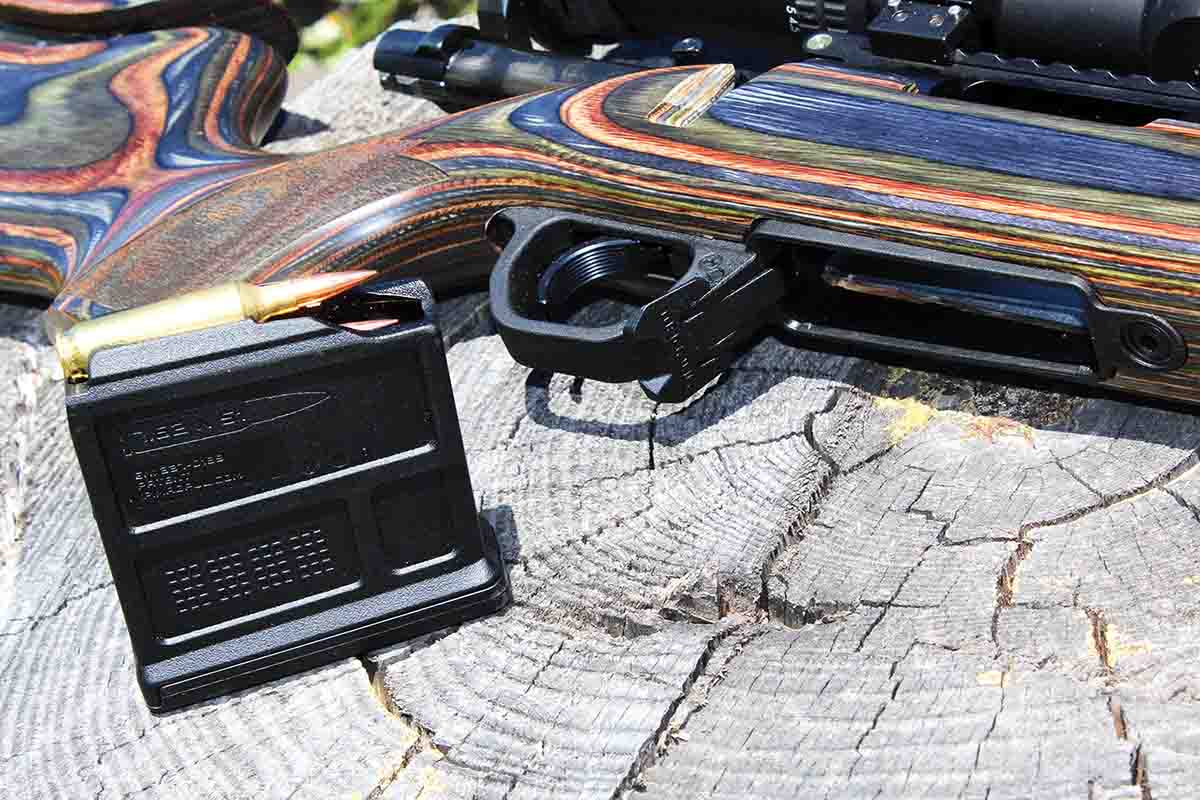
As with any new wildcat cartridge, it’s difficult to determine where actual maximum loads lay without the benefit of pressure equipment, or at least factory ammunition to use as a baseline for measured case expansion. With more time I will undoubtedly work that out but I am more than pleased with where I have begun. Without exception, with every single load tested, bolt lift was effortless and primers showed no sign of excessive pressure with any loads listed. Readers should approach all listed loads with all due caution, as every rifle chamber and case are a bit different. Referencing QuickLoad data for Berger’s 85.5-grain Long Range Hybrid Target bullet (supplied by friends at Capstone Precision), comparing Alliant Reloder 26, Norma MRP and Vihtavuori N560 velocities to what I’ve produced in the real world, I’ve easily matched projected maximum velocities.
The .22 Creedmoor (and this rifle especially) is a definite winner. It is ready for varmints or predators, dealing with windy conditions or even pursuing pronghorn to deer-sized big game. Whether the .22 CM will ever go mainstream, I cannot guess, though the Creedmoor name does seem to carry considerable sway.



.jpg)